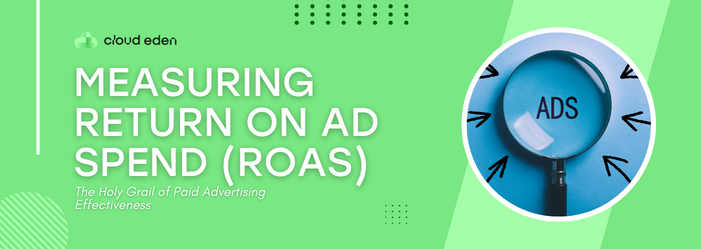Measuring Return on Ad Spend (ROAS)

Table of Contents
Introduction
- In the Ever-Competitive World of Digital Marketing
Measuring Return on Ad Spend (ROAS): The Holy Grail of Paid Advertising Effectiveness
Demystifying ROAS: Understanding the Core
Why is ROAS Important?
Calculating Your ROAS: A Simple Formula with Profound Impact
- Example
Beyond the Basics: Advanced ROAS Applications for Strategic Advantage
- ROAS by Channel
- ROAS by Device
- ROAS by Audience Segment
- Customer Lifetime Value (CLV) Integration
- Time-Based ROAS Analysis
Mastering the Art of ROAS: Practical Tips and Strategies
- Setting Realistic ROAS Goals
- Focus on Conversion Tracking
- A/B Testing is Your Friend
- Embrace Attribution Models
- Leverage Automation Tools
Beyond ROAS: A Holistic View of Campaign Success
- Brand Awareness
- Customer Acquisition Cost (CAC)
- Engagement Metrics
The Final Word: ROAS – Your Guide to Paid Advertising Success

In the ever-competitive world of digital marketing, where budgets are tight and results are paramount, measuring the success of your advertising efforts is crucial. Enter Return on Ad Spend (ROAS), a metric that stands as the shining beacon for paid advertising campaigns. By understanding and tracking ROAS, you gain valuable insights into the effectiveness of your ads, allowing you to optimize campaigns, maximize your return on investment (ROI), and ultimately drive business growth.
This article delves deep into the world of ROAS, exploring its intricacies, applications, and the strategic power it holds for businesses of all sizes. We'll unpack the core concepts, guide you through the calculation process, and explore advanced ROAS applications to empower you to become a master of paid advertising measurement.
Demystifying ROAS: Understanding the Core
ROAS stands for Return on Ad Spend. Simply put, it's a financial metric that tells you how much revenue you generate for every dollar you invest in your advertising campaigns. It's a ratio that reflects the efficiency of your ad spend, indicating whether your campaigns are generating a positive return or if you're bleeding money.
Why is ROAS Important?
Imagine pouring money into an advertising campaign without knowing if it's actually generating sales. That's the danger of operating in the dark. ROAS sheds light on the performance of your paid ads, providing a benchmark to gauge their effectiveness. Here's why ROAS matters:
- Optimizes Campaign Allocation: By analyzing ROAS across different campaigns and platforms, you can identify the high performers and strategically allocate your budget towards them. This ensures you're maximizing your return across all advertising channels.
- Identifies Inefficiencies: A low ROAS might indicate poorly targeted ads, irrelevant creatives, or landing pages that don't convert. By tracking ROAS, you can pinpoint areas for improvement and refine your campaigns for better performance.
- Demonstrates Advertising Value: ROAS provides data-driven evidence to stakeholders about the value advertising generates. By showing a positive ROAS, you can justify advertising spend and secure future budgets for successful campaigns.

Calculating Your ROAS: A Simple Formula with Profound Impact
Calculating ROAS is a straightforward process. Here's the formula:
ROAS = Total Conversion Value / Ad Spend
- Total Conversion Value: This represents the total revenue generated from your advertising efforts. It can be calculated by multiplying the number of conversions by the average order value (AOV) for your product or service.
- Ad Spend: This is the total amount of money you spend on your advertising campaign. This includes the cost of the ad placements, platform fees, and any additional advertising management costs.
Example:
Let's say you spend $1,000 on a Google Ads campaign that generates 20 sales with an average order value of $50. Here's how to calculate your ROAS:
- Total Conversion Value = 20 sales * $50/sale = $1,000
- ROAS = $1,000 (Total Conversion Value) / $1,000 (Ad Spend) = 1
In this scenario, your ROAS is 1, which means you're breaking even – for every dollar you spent on advertising, you generated $1 in revenue. However, the goal is to achieve a ROAS that's greater than 1, indicating a positive return on investment.
Beyond the Basics: Advanced ROAS Applications for Strategic Advantage
While the core calculation remains simple, ROAS analysis can be taken to a deeper level to unlock strategic insights. Here are some advanced applications to consider:
- ROAS by Channel: Analyze ROAS across different advertising channels like Google Ads, social media advertising, and display advertising. This helps you identify the most cost-effective channels for reaching your target audience.
- ROAS by Device: Measure ROAS for desktop, mobile, and tablet traffic. This can reveal user behavior patterns and allow you to optimize your campaigns for specific devices.
- ROAS by Audience Segment: Analyze ROAS for different audience segments based on demographics, interests, or behavior. This helps you understand which audience segments deliver the highest return and tailor your ad creatives and targeting accordingly.
- Customer Lifetime Value (CLV) Integration: Consider factoring customer lifetime value (CLV) into your ROAS analysis. CLV represents the total revenue a customer is expected to generate over their relationship with your business. By integrating CLV, you get a more holistic view of your advertising ROI, as a seemingly low ROAS from an initial purchase might be offset by future repeat business.
- Time-Based ROAS Analysis: Track ROAS over time to understand campaign performance trends. Analyze seasonal fluctuations and identify periods where adjustments might be necessary

Mastering the Art of ROAS: Practical Tips and Strategies
Understanding the calculation and applications of ROAS is just the first step. Here's how to truly master this metric and unlock its full potential:
- Setting Realistic ROAS Goals: Don't expect a 10:1 ROAS from the get-go. Research industry benchmarks for your specific niche and advertising platform. Start with achievable goals and gradually optimize your campaigns to improve your ROAS over time.
- Focus on Conversion Tracking: The accuracy of your ROAS calculation hinges on effective conversion tracking. Ensure your website or landing pages are set up with proper conversion tracking tools to capture sales, leads, or any other desired action.
- A/B Testing is Your Friend: Don't be afraid to experiment! A/B test different ad creatives, landing pages, targeting options, and even ad formats to see what resonates best with your audience. A slight improvement in conversion rate can significantly boost your ROAS.
- Embrace Attribution Models: The customer journey often involves multiple touchpoints before a conversion occurs. Utilize attribution models within your analytics platform to understand how different ad interactions contribute to a sale. This helps you give credit to the right channels and optimize your ad spend accordingly.
- Leverage Automation Tools: Paid advertising platforms offer automation tools that can help you optimize your campaigns based on ROAS goals. These tools can automatically adjust bids and budgets to maximize your return.
Beyond ROAS: A Holistic View of Campaign Success
While ROAS is a powerful metric, it shouldn't be the sole measure of your advertising success. Here are some additional factors to consider for a comprehensive evaluation:
- Brand Awareness: Paid advertising can also build brand awareness and brand perception, even if it doesn't directly translate into immediate sales. Track metrics like impressions, reach, and brand mentions to understand the broader impact of your campaigns.
- Customer Acquisition Cost (CAC): Analyze your customer acquisition cost (CAC), which represents the average cost of acquiring a new customer. Ideally, your ROAS should be higher than your CAC to ensure you're generating a profit on each new customer acquired.
- Engagement Metrics: Track engagement metrics like click-through rates (CTR) and time spent on landing pages. These metrics, while not directly tied to revenue, can indicate how well your ads resonate with your target audience.
By considering ROAS alongside these additional factors, you gain a well-rounded picture of your advertising performance and make data-driven decisions to optimize your overall marketing strategy.
The Final Word: ROAS – Your Guide to Paid Advertising Success
In conclusion, ROAS is more than just a number; it's a guiding light for your paid advertising efforts.
By understanding the core concepts, mastering the calculation methods, and implementing strategic applications, you can leverage ROAS to:
- Optimize your campaigns for maximum efficiency and return
- Allocate your advertising budget wisely across different channels and audiences
- Demonstrate the value of advertising to stakeholders and secure future budgets
- Ultimately, achieve your business goals and drive sustainable growth
Embrace ROAS as a vital tool in your marketing arsenal, and watch your paid advertising campaigns transform from black boxes into engines of revenue generation. Remember, paid advertising is an ongoing process of experimentation and optimization. By continuously analyzing your ROAS and implementing data-driven adjustments, you'll be well on your way to paid advertising mastery.
Welcome To Our Blog





